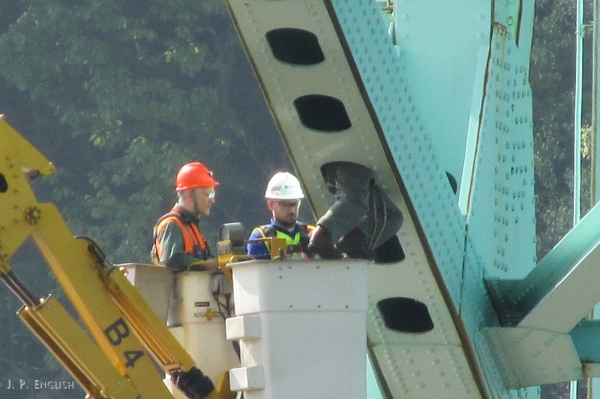
A small, enthusiastic crowd was on hand yesterday morning for the peregrine banding at the Tarentum Bridge, rewarded by close looks — and photos — of the two peregrine chicks: one male and one female.
The event began at the boat launch parking lot where viewers watched as the PA Game Commission’s Dan Brauning and Tom Keller and the PennDOT crew swung the bucket under the bridge to the nest hole on the main-channel arch. We knew the nest location because Rob Protz, myself, and others had seen juvenile peregrines peeking from the hole.

The adult peregrines(*) attacked but could not deter the banders. However, when the bucket got to the nest hole the two chicks were huddled far inside out of reach. Tom Keller crawled into the hole! Look at him stand on the bucket edge before he disappeared inside! Yow!

Tom retrieved the chicks and the bucket swung up to the sidewalk to weigh and band them. The crowd joined to watch.

Each chick received two bands: US Fish & Wildlife on the right leg, color band on the left leg. Here, Dan Brauning crimps the silver USFW band.

Dan estimated the chicks were 35 days old yesterday — only four to nine days away from first flight. Rather then put them back in the nest hole, exposed over open water, Dan wet them down (to keep them from trying to fly right away) and placed them on the mid-river bridge pier where there’s a good “runway” for take off.
Stop by the Tarentum Bridge soon to watch these young peregrines. They’ll be making their first flight some time between Memorial Day and the end of the month.

Let the fun begin!
(Thanks to photographers Sean Dicer, Mike Fialkovich and John English for generously lending their photos)
(*) The adult peregrines are Hope (black/green 69/Z) and an unidentified male.
p.s. Click here for Mary Ann Thomas’ report at Alle-Kiski TRIBlive
It was also interesting to watch the Allegheny rise about a foot while we were there! The fishing pier we stood on to take photos at 9:00 was submerged by 11:00.
Allegheny River: whoa!
“Let the fun begin!”
Yes, in the immortal words of Art McMorris: “Who needs TV when you have Peregrine Falcons!” 🙂
Yay! Thanks to Dan, Tom & PennDOT!
Great article!!
Unbelievable. You guys really know your stuff. What did the Peregrine Mom lay her eggs on inside that bridge’s main channel arch? In that situation would they ever bring in nest material for some cushion and insulation? I will read your page Kate “Sitting on eggs- or not” to see if that page discusses my question. Thanks for exciting coverage. I would have loved to be there.
John, peregrines do not bring in nest material. The site has to have substrate (dust, gravel, debris) which they then shape into a nest scrape.
Thanks Kate they have a rough start in life. Gravel mattress.
Actually John, this was is dirt if it’s the same as last year. Art McMorris took a picture last year when we only had one unhatched egg. The floor of the scrape chamber was all dirt.
Thanks Rob I feel better about there scrape they are a tough bunch. Thinking of first 6 weeks in mostly darkness seems to be a disadvantage.